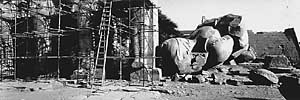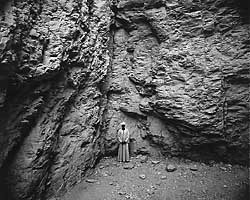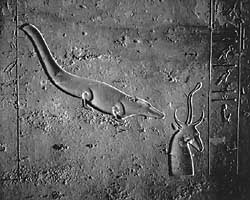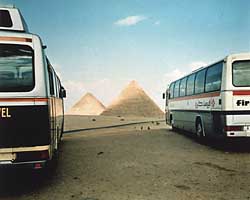Oriental Institute exhibits work by four American photographers in Egypt
By Seth SandersNews Office
 Ramesseum, Fallen Head, French Scaffolding (1991) selenium-toned silver gelatin print 7 1/2 x 21 5/8, by Tom Van Eynde |
Visitors may see striking ancient monuments through distinctively modern eyes at the Oriental Institute through Sunday, Jan. 27, 2002. A current exhibition titled “Angle of Repose: Four American Photographers in Egypt” features photographs by Linda Connor, Lynn Davis, Tom Van Eynde and Richard Misrach from the collection of LaSalle Bank. The images range from sweeping views of the monuments of Luxor to scenes of modern Egyptian life in the shadows of the pyramids.
“Photography has always played an important role in our scholarly work, and it is a fascinating contrast to see Egypt through the lens of an artist rather than from the viewpoint of an archaeologist,” said Gene Gragg, Director of the Oriental Institute.
Twenty-five photographs were selected from the LaSalle Bank Photography Collection, which was founded in 1967. It is one of the oldest corporate-sponsored collections of photography in America. The collection now comprises more than 4,000 photographs and is exhibited on a rotating basis at the LaSalle Bank headquarters in Chicago.
 Karnak Temple, Man Sweeping Hypostyle Hall at Dawn (1988) selenium-toned silver gelatin print 7 5/8 x 21 5/8, by Tom Van Eynde |
In 1993, the bank began acquiring photographs that reflect how 19th- and 20th-century photographers have portrayed Egypt, its people and its ancient monuments. “For years the bank has been interested in and supported the work of the Oriental Institute,” said Thomas Heagy, Chief Financial Officer of ABN AMRO North America and Vice Chairman of LaSalle Bank. Our collaboration allows a greater number of people to see this extraordinary collection.” The exhibition will inaugurate the Holleb Family Temporary Exhibits Gallery, part of an ongoing renovation of the Oriental Institute galleries.
 Abrahim, Valley of the Kings (1989) gold-toned silver gelatin printing out paper 7 7/8 x 9 7/8, by Linda Connor |
The four contemporary American photographers––Connor, Davis, Van Eynde and Misrach––have worked in Egypt during the last two decades. Each had a fascination with the desert landscape and Egypt’s ancient monuments. The photographs now on view represent very different personal responses to the monuments of Egypt, subjects that have endlessly been represented in the West through paintings, drawings, photographs and words. The exhibition shows that attention to the minute details, geographical orientation in vast landscapes and living social context of the monuments can reveal powerful new dimensions of these objects.
As Sarah Anne McNear, director of the Museum of Contemporary Photography at Columbia College in Chicago and curator of the LaSalle Bank Photography Collection, wrote: “Their pictures of Egypt ... allude to the particular history of photographic practice there as well as the more general tradition of expeditionary travel and its intent at the close of the 20th century.”
 Crocodile, Valley of the Kings (1989) gold-toned silver gelatin printing out paper 7 5/8 x 9 5/8, by Linda Connor |
Connor’s photographs closely echo 19th-century images of Egypt in great part because of her use of a large format view camera, such as those used by the first photographers in Egypt. She creates contact prints of her 8-by-10 inch negatives on paper that she tones to various warm gray or reddish-brown shades, which further evoke the mood of earlier photographs.
Davis’ primary frame of reference is the work of the 19th-century photographer Francis Frith. Working with a hand-held Rolliflex camera that produces a two-inch-square negative, Davis enlarges her negatives to a final print size, often as big as four feet by four feet, which reflects her monumental subjects.
 Tour Buses and Pyramids (1989) Dye coupler print, 20 x 24, by Richard Misrach |
As a member of the Oriental Institute’s Epigraphic Survey from 1987 to 1993, Van Eynde was responsible for producing highly technical photographs of the monuments, his lens never more than five feet from the wall surface. In stark contrast are his panoramic views that allow him to place monuments in a broad topographical context.
Misrach’s photos are a “prologue” to a larger, multifaceted series titled The Desert Cantos. His use of color film and the juxtapositions of ancient and modern subjects underscore the fact that his pictures are contemporary, a view of modern life rather than an imagined past.
An illustrated catalog titled The Angle of Repose: Four American Photographers in Egypt, by McNear, with endnotes by Emily Teeter, Research Associate and Curator of the Egyptian and Nubian Antiquities at the Oriental Institute, is available at the institute.
The Oriental Institute is at 1155 E. 58th St. Hours are 10 a.m. to 4 p.m. Tuesday, 10 a.m. to 8:30 p.m. Wednesday, 10 a.m. to 4 p.m. Thursday through Saturday and noon to 4 p.m. Sunday. The institute is closed on Mondays and major holidays. Admission is free, and more information is available by phoning (773) 702-9514.
![[Chronicle]](/images/small-header.gif)